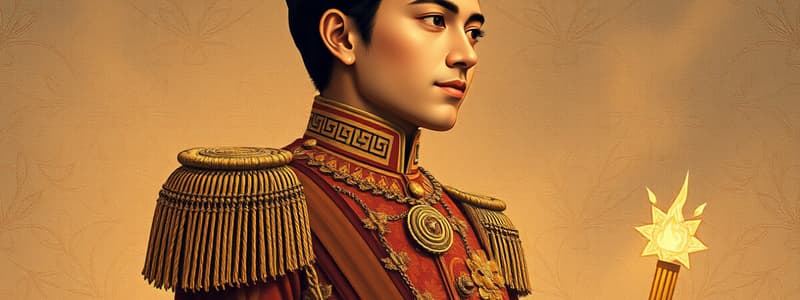Podcast
Questions and Answers
When was the Act of Proclamation of Independence of the Filipino people declared?
When was the Act of Proclamation of Independence of the Filipino people declared?
June 12, 1898
Who read the declaration of independence?
Who read the declaration of independence?
Ambrosio Rianzares Bautista
What year did Emilio Aguinaldo declare Philippine Independence Day?
What year did Emilio Aguinaldo declare Philippine Independence Day?
- 1896
- 1946
- 1898 (correct)
- 1897
What is the significance of the eight rays of the sun in the Philippine flag?
What is the significance of the eight rays of the sun in the Philippine flag?
Match the following dates with their significance:
Match the following dates with their significance:
Emilio Aguinaldo was born on March 22, 1869.
Emilio Aguinaldo was born on March 22, 1869.
Emilio Aguinaldo joined Katipunan with the name ______.
Emilio Aguinaldo joined Katipunan with the name ______.
Who was the Supremo of Katipunan?
Who was the Supremo of Katipunan?
The declaration of independence was a 10-page document.
The declaration of independence was a 10-page document.
What major event occurred on May 10, 1897?
What major event occurred on May 10, 1897?
Flashcards are hidden until you start studying
Study Notes
Proclamation of Independence of the Filipino People
- December 1897: Truce declared with Emilio Aguinaldo agreeing to exile in Hong Kong.
- Aguinaldo funded the purchase of rifles and ammunition for P117,000; initial shipment worth P50,000, remaining shipment did not arrive.
- May 19, 1898: Aguinaldo returned to the Philippines aboard the U.S. cruiser McCullough.
- May 28, 1898: Filipino forces achieved their first victory in Alapan, Imus, Cavite.
- May 24, 1898: Establishment of a Dictatorial Government by Aguinaldo.
- June 12, 1898: Declaration of Philippine Independence by Emilio Aguinaldo.
- June 12, 1946: Official recognition of Philippine Independence Day.
- Ambrosio Rianzares Bautista read the independence declaration, signed by 117 individuals, including an American military officer.
- National Anthem "Marcha Nacional Filipina," composed by Julian Felipe, performed by Banda de San Francisco de Malabon.
- Emilio Aguinaldo born on March 22, 1869, in Kawit, Cavite.
- Aguinaldo joined Katipunan, using the alias Magdalo; rival faction in Cavite named Magdiwang.
- Andrés Bonifacio served as Supremo of Katipunan.
- March 22, 1897: Elections for a revolutionary government held in Barrio Tejeros, San Francisco de Malabon.
- May 10, 1897: Death of Andrés Bonifacio and his brother Procopio.
- June 10, 1896: Gen. Emilio Aguinaldo appointed Ambrosio Rianzares Bautista as "Special Commissioner" to write the Act of Independence.
- Act of Independence is a 16-page document signed by 117 individuals.
- Philippines underwent 333 years of colonization by Spaniards and Americans.
- The eight rays of the Philippine flag represent the provinces of Manila, Cavite, Bulacan, Pampanga, Nueva Ecija, Bataan, Laguna, and Batangas.
- The white triangle symbolizes fraternity, representing the Katipunan.
- The three stars stand for Luzon, Panay, and Mindanao.
Studying That Suits You
Use AI to generate personalized quizzes and flashcards to suit your learning preferences.




